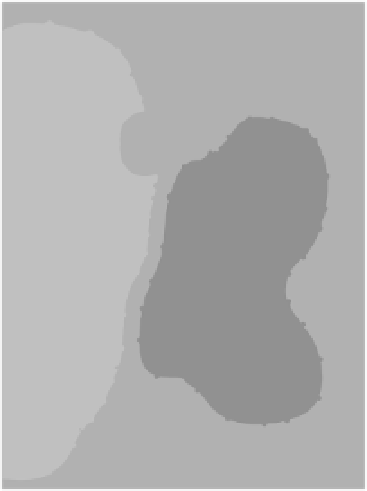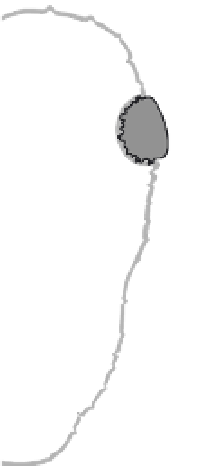Biomedical Engineering Reference
In-Depth Information
CARBON
DIOXIDE
CAPILLARY
RED
BLOOD
CELL
ALVEOLUS
OXYGEN
FIGURE 3.26
During external respiration, oxygen moves from the alveoli to the blood, and carbon dioxide
moves from the blood to the air within the alveoli.
movement of a gas depends on the partial pressures of the gas in the blood and the extra-
cellular fluid, the surface area available for diffusion, the thickness of the membrane that
the gas must pass through, and a diffusion constant that is related to the solubility and
molecular weight of the gas (Fick's Law).
Mechanical ventilators can be used to deliver air or oxygen to a patient. They can be
electrically or pneumatically powered and can be controlled by microprocessors. Negative
pressure ventilators, such as iron lungs, surround the thoracic cavity and force air into
the lungs by creating a negative pressure around the chest. This type of ventilator greatly
limits access to the patient. Positive pressure ventilators apply high-pressure gas at the
entrance to the patient's lungs so air or oxygen flows down a pressure gradient and into
the patient. These ventilators can be operated in control mode to breathe for the patient
at all times or in assist mode to help with ventilation when the patient initiates the breath-
ing cycle. This type of ventilation changes the pressure within the thoracic cavity to positive
during inspiration, which affects venous return to the heart and cardiac output (the amount
of blood the heart moves with each beat). High-frequency jet ventilators deliver very rapid
(60-90 breaths per minute) low-volume bursts of air to the lungs. Oxygen and carbon
dioxide are exchanged by molecular diffusion rather than by the mass movement of air.
This method causes less interference with cardiac output than does positive pressure venti-
lation. Extracorporeal membrane oxygenation (ECMO) uses the technology that was devel-
oped for cardiopulmonary bypass machines. Blood is removed from the patient and passed
through an artificial lung, where oxygen and carbon dioxide are exchanged. It is warmed to
body temperature before being returned to the patient. This technique allows the patient's
lungs to rest and heal themselves and has been used successfully on some cold water
drowning victims and on infants with reversible pulmonary disease.














































































